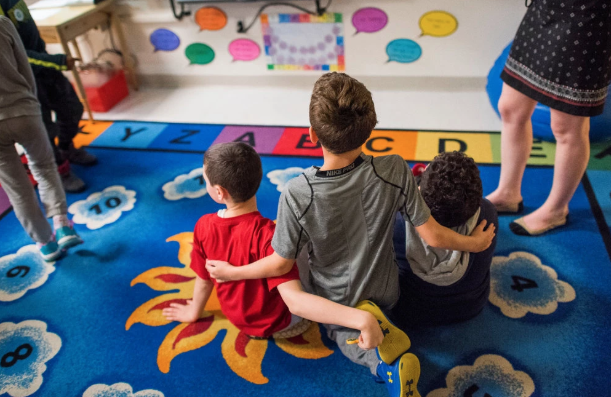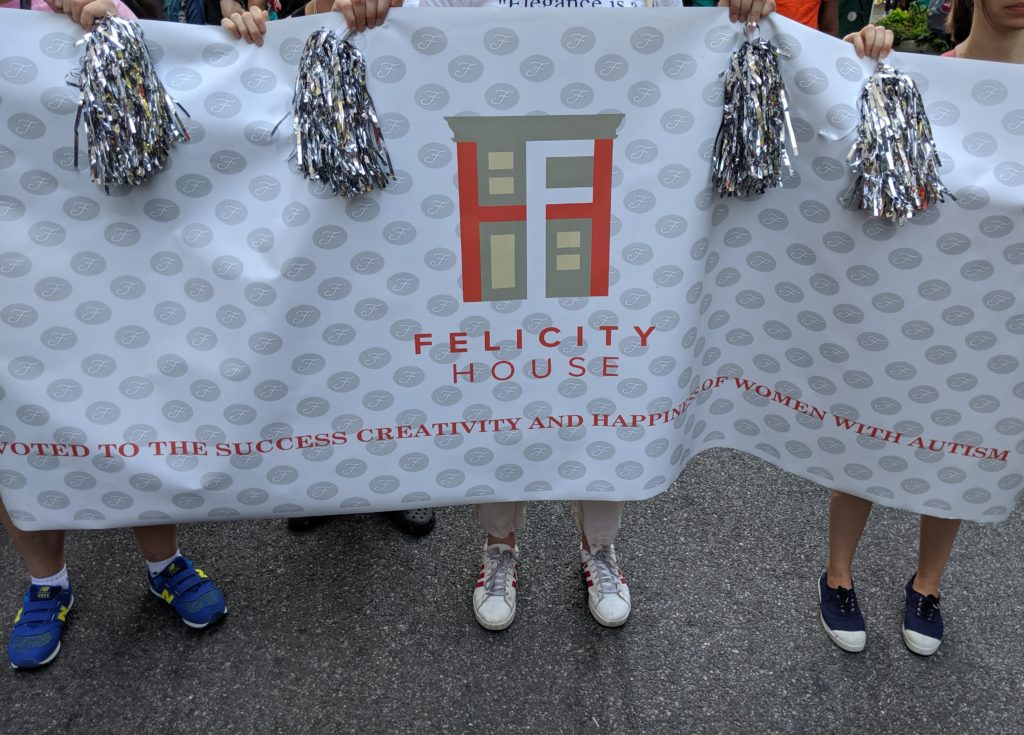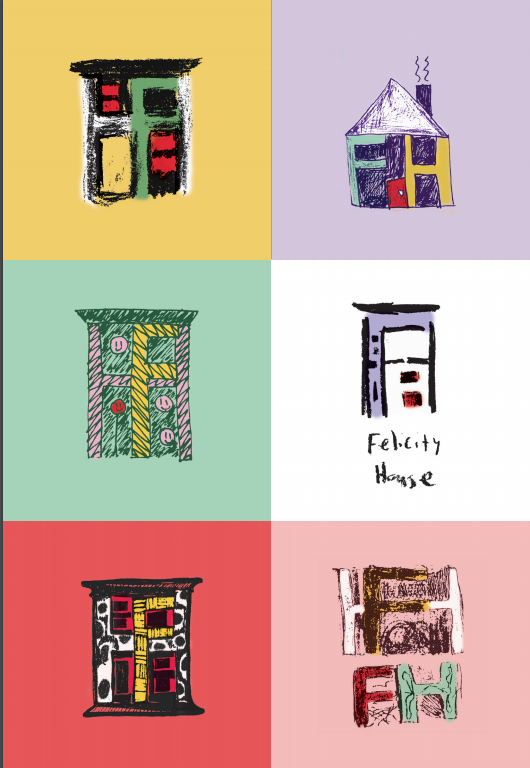All posts by Felicity House
We had a great summer at Felicity House. To celebrate the season of sun, we planned summer-focused activities. In our Circles, which are small social meetings (you can read more about them here), we enjoyed a Mixology demo and made our own zen sand boxes.
Our DIY zen gardens were created by using wooden boxes that we decorated using paint and markers. We then added sand, rakes, shells and gratitude rocks. The beach-themed boxes will help us enjoy summer all year round!

For Mixology, we brought in a professional mixologist who taught us how to blend three summer drinks. These non-alcoholic beverages were the perfect way to cool off on a hot day. The drink shown below was a magical Butterfly Lemonade with a base of tea and lemons that changed colors when we added certain ingredients. Check out the recipe below.

Butterfly Lemonade Recipe
Ingredients:
• 5 Tablespoons of Azul tea (this can be ordered online and includes Butterfly Pea – Lemon Verbena – Lemongrass)
• 5 Whole Lemons
• Maple Syrup
• Ice
• Filtered or Spring Water
Directions:
Brew Azul Tea in French Press, let it sit for ten minutes. While waiting, juice lemons separately. After ten minutes, add lemon juice to Azul Tea and
watch it transform from dark purple to bright pink! Add Maple Syrup to taste. Serve with ice and garnish with lemon wedge. Enjoy!
In the summer of 2019 Anna North, novelist and senior reporter at Vox visited Felicity House. Anna later shared her experience in her article Inside Felicity House, a New York social club for women with autism. In the article, Anna beautifully captured the voices of our community members:
“There is really something to be said about being in a place where you don’t need to translate yourself,” said Christine, a 29-year-old member of the house. (To maintain their privacy, all members interviewed by Vox asked that only their first names be used.) “Walking into Felicity House was weirdly like walking into a place where everyone spoke my language.”
Another community member shared the importance of having a female-only space: “In college, I was the only woman in my life-skills group … I stopped going after a few weeks because I couldn’t connect.”
We are thrilled for the opportunity to publicly share Felicity House through our community members’ own voices. Click here to read the full article or here to read other published articles on Felicity House.
On Sunday July 14th, New York City hosted its fifth annual Disability Pride Parade, an event to “promote inclusion, awareness, and visibility of people with disabilities, and redefine public perception of disability.”
Felicity House’s community members joined the parade, cheering with pom poms and chants, to march from Madison Square Park down to Union Square. We were proud to represent both Felicity House and adult women with autism.
On May 20th, Felicity House hosted an Open Door event with Broadway actress, Ali Stroker. Ali performed some of her favorite show tunes and gave an inspirational talk about her career and journey toward success.
On June 9th, Ali made history by becoming the first wheelchair user to win a Tony when she took home the award for “best featured actress” in a musical for her performance as Ado Annie in “Rodgers & Hammerstein’s Oklahoma!”
We loved having Ali at Felicity House and we can’t wait to see where she goes next!

“This award is for every kid who is watching tonight who has a disability, who has a limitation or a challenge, who has been waiting to see themselves represented in this arena — you are,” she said, in her award acceptance speech.
We are excited to share with you our first Felicity House zine (short for magazine or fanzine). The zine was created by our participants to share a glimpse of what our community is like – creative, welcoming and supportive.
We would love to know what community means to you too! Send us a postcard to 25 E. 22nd Street, New York, NY 10010 or email us at info@felicity-house.org. You can also email us a request to receive a physical copy of the zine. To print or view our zine, click here.
“I remember walking around and growing quite emotional the more I saw and heard about the space. It’s such a well-thought out concept with rooms that people can go to in and sit in by themselves – to a more sociable lounge.” – Mahlia Amatina, describing her first time visiting Felicity House

Mahlia Amatina is an award-winning artist who received an autism diagnosis in 2015. She was inspired by her diagnosis to create art that reflects the creativity and multi-sensory experience of neurodiversity. A few months ago, Mahlia had the opportunity to visit Felicity House and wrote about it on her blog. Mahlia describes Felicity House as a sanctuary away from the bustling streets of New York. You can read more about her experience here.
Did you know that Felicity House has an art collection composed completely of female artists? We take great pride in making sure our space is warm and inviting. For this reason, we carefully selected artworks that will reflect a welcoming vibe and inspire creativity among our community. We worked with an assortment of artists to curate several pieces made by women with autism and also other female artists.
Here are some of our favorite pieces:
Susan Brown’s “Her Mother”

About the artist:
Susan Brown was born in 1957 and was diagnosed with autism as a young child. She began drawing at the age of five. Her work has been shown in Pure Vision Arts’ exhibitions at the Cooper Union Great Hall Gallery, Marlborough Gallery, Ricco Maresca Gallery, the Museum of American Folk Art and The New York Transit Museum, as well as at many other New York venues.
Elisa Huberman:

About the Artist:
Elisa Huberman is an artist, filmmaker, illustrator, and author. Her art has been featured in JCC’s Artistic Spectrum, at Pure Vision Arts and in her new children’s book, The Upside Down Giraffe.
Rebeca Raney’s “Hair Drawing 15”

About the Artist:
Rebeca is a New York-based artist who creates drawings and sculptures in her studio in Brooklyn. Rebeca graduated with a MFA from the School of Visual Arts. Rebeca is also the resident guest artist at Felicity House, available during Open Hours to help support community members with their ongoing art projects.
Christina Watka’s: “Murmuration IX”

About the artist: Christina is a large-scale installation artist who creates custom art that’s site-specific. She received her BFA from The New England School of Art and Design. She uses porcelain to replicate dynamic patterns in nature like swarms, flocks, cells, constellations, and topographical maps.
On December 11th, Felicity House hosted a public concert with a string quartet from The Juilliard School. Playing classics like Bach and Beethoven, the musicians also entertained the audience with some seasonal pieces and music from Star Wars: The Force Awakens. The concert was followed with a festive reception full of delicious food and friendly faces.
On October 18th, Felicity House hosted members of its Self Advocate Advisory Board for a robust panel discussion about women with autism. The panel was moderated by Felicity House’s President and Founder, Audrey Cappell.
Panelists included: Julia Bascom: Executive Director, Autistic Self Advocacy Network (ASAN); Sharon daVanport: Founder and Executive Director, Autistic Women & Nonbinary Network (AWN Network); Morenike Giwa Onaiwu: community advocate, writer, ASAN & AWN Network board member; Liane Holliday Willey: spokesperson & author of Pretending to Be Normal & Safety Skills for Asperger Women; Lindsey Nebeker: Developmental Specialist, Autism Society of America; featured subject in Emmy-nominated documentary Autism in Love; and Brigid Rankowski: disability rights advocate, founder of The Way We Move Social Circus, and head of the Autism Society of Maine’s Education Committee

On July 14th, the New York Times published an Op Ed: “How to Meet Autistic People Halfway,” which highlighted a common, unfortunate misconception about people on the autism spectrum; that they are not interested in connecting socially with others. Because Felicity House is devoted to the success, creativity and happiness of women with autism, and we can’t imagine leading a successful, creative or happy life in isolation from friends and others, we felt we had to respond, and submitted the following letter:
There should be no question that autistic people need and value social connections. We all do. I see every day how deeply it matters to women with autism to enjoy the company and support of other women and to be a part of a community that is fun, social, supportive and affirming.
As autistic people have been advocating for decades, let’s create more environments and opportunities for positive social and recreational experiences, behaviors related to autism notwithstanding. It should not be a radical idea that one can make a friend without making eye contact, or have an engaging conversation while flapping one’s hands. The importance of enjoying time with others and making human connections in life cannot be overstated.
It is time to stop asking autistic people to adapt their social behavior to fit mainstream expectations. Especially when we see in spaces that allow people to come together in ways that are comfortable for them, powerful social connections can be made.
Click here to see how our letter was represented in the New York Times, both online and in print.






